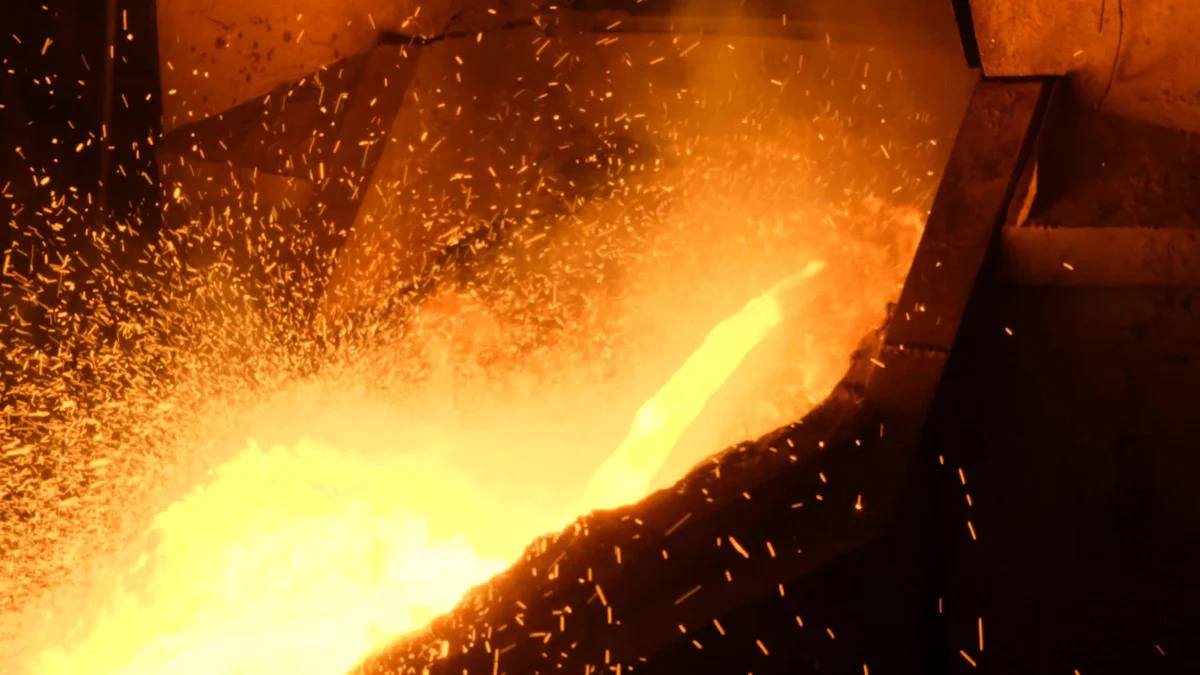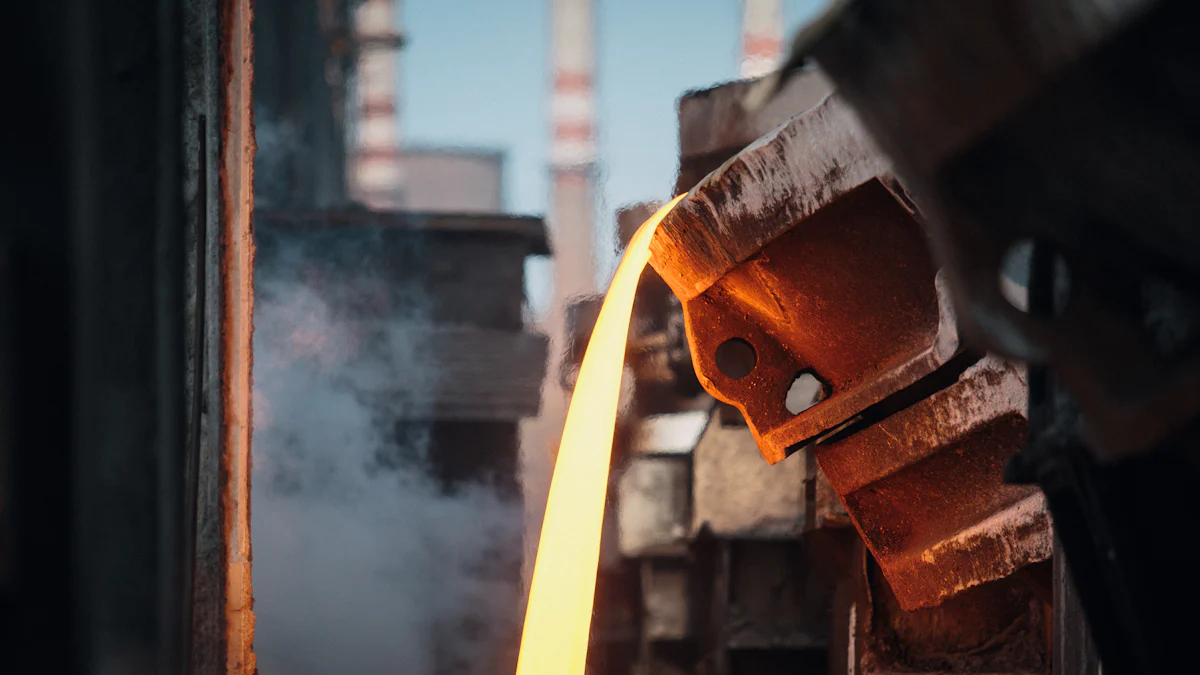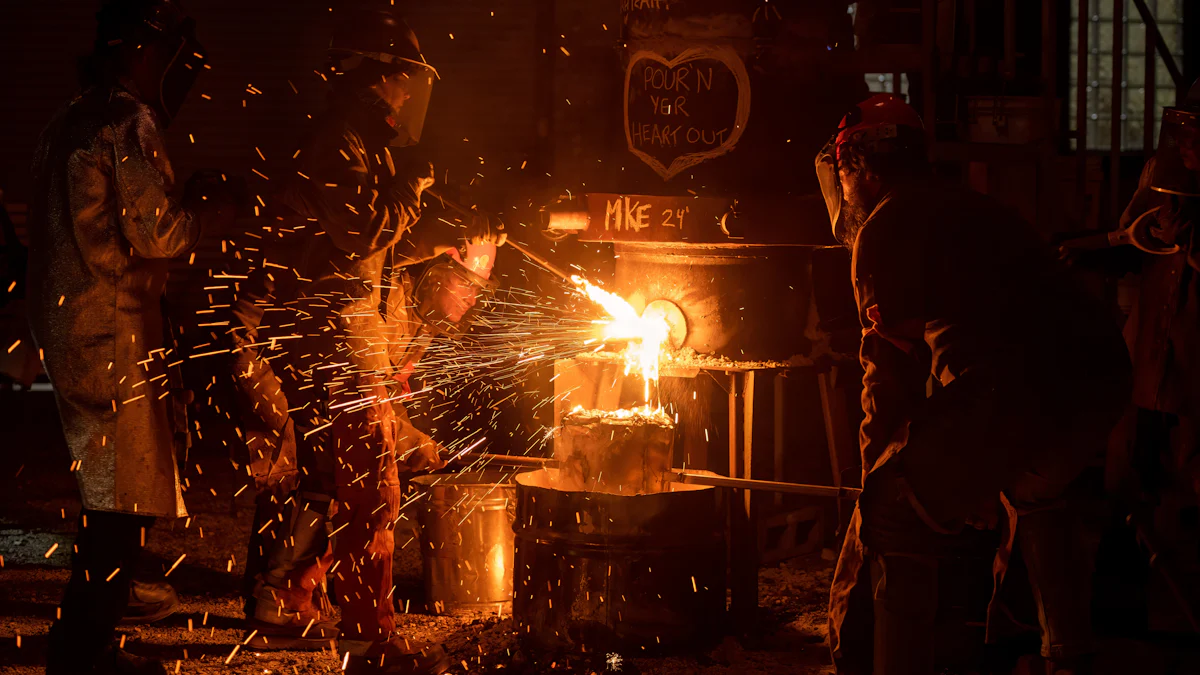
When I think about the melting point of brass, I consider its unique range. Brass, an alloy primarily composed of copper and zinc, melts between 900°C and 940°C (1652°F to 1724°F). This range depends on the specific alloy composition. The proportions of copper and zinc significantly influence this melting point. For instance, brass with a higher copper content tends to melt at slightly higher temperatures. Understanding these variations is crucial for anyone working with brass, whether in industrial applications or artistic endeavors.
Key Takeaways
- Brass melts between 900°C and 940°C (1652°F to 1724°F), with variations depending on its copper and zinc composition.
- Different brass grades, like cartridge brass and admiralty brass, have distinct melting points influenced by their specific alloy compositions.
- Zinc content significantly affects the melting point; higher zinc levels generally lower the melting temperature, making it suitable for casting applications.
- Safety is crucial when melting brass; always wear protective gear and ensure proper ventilation to avoid harmful fumes.
- Two primary melting techniques are furnace melting, which offers control, and torch melting, which is more flexible for smaller projects.
- Understanding the melting point of brass is essential for optimizing manufacturing processes and ensuring quality in both industrial and artistic applications.
- Brass’s melting point is lower than copper but higher than aluminum, making it versatile for various applications requiring different thermal properties.
Melting Temperature of Different Brass Grades

Understanding the melting temperature of various brass grades helps me appreciate the versatility of this alloy. Brass, with its unique blend of copper and zinc, offers a range of melting points that cater to different applications. Let’s delve into some common brass grades and explore how their compositions influence their melting temperatures.
Common Brass Grades
Cartridge Brass
Cartridge brass, known for its excellent ductility and strength, typically contains about 70% copper and 30% zinc. This composition results in a melting point that hovers around 900°C (1652°F). I find cartridge brass particularly useful in applications requiring high malleability, such as in the manufacturing of ammunition casings and musical instruments.
Admiralty Brass
Admiralty brass, on the other hand, includes a small percentage of tin, which enhances its corrosion resistance. This grade usually melts at slightly higher temperatures, ranging from 920°C to 940°C (1688°F to 1724°F). Admiralty brass is ideal for marine environments, where resistance to seawater corrosion is crucial.
Variations in Melting Points
The melting point of brass can vary significantly based on its composition. I often consider two main factors that influence these variations: the zinc content and the presence of other alloying elements.
Influence of Zinc Content
Zinc plays a pivotal role in determining the melting point of brass. Higher zinc content generally lowers the melting temperature. For instance, brass with a zinc content exceeding 35% may melt at temperatures closer to 900°C (1652°F). This property makes high-zinc brass suitable for applications where lower melting points are advantageous, such as in casting processes.
Influence of Other Alloying Elements
Additional elements like lead, tin, or manganese can further alter the melting point of brass. Lead, often added to improve machinability, can slightly reduce the melting temperature. Tin, as seen in admiralty brass, increases corrosion resistance and can raise the melting point. Manganese, when added, enhances strength and wear resistance, potentially affecting the thermal properties of the alloy.
Factors Affecting the Melting Point of Brass
Understanding the factors that influence the melting point of brass helps me appreciate its complexity and versatility. The melting point of brass, an alloy primarily composed of copper and zinc, can vary significantly based on several key factors.
Composition of Brass
The composition of brass plays a crucial role in determining its melting point. I often consider how the proportions of copper and zinc, along with other elements, impact this property.
Role of Copper and Zinc
Copper and zinc form the backbone of brass. Copper, with its higher melting point, tends to increase the overall melting temperature of the alloy. In contrast, zinc lowers it. For instance, brass with a higher copper content will generally have a higher melting point. This balance between copper and zinc allows for the creation of various brass grades, each with unique melting characteristics.
Impact of Additional Elements
Additional elements can further modify the melting point of brass. Lead, often added to improve machinability, can slightly reduce the melting temperature. Tin, known for enhancing corrosion resistance, may increase the melting point. These elements, when introduced into the alloy, alter its thermal properties and expand its range of applications.
Environmental Conditions
Environmental conditions also play a significant role in affecting the melting point of brass. I find it fascinating how factors like pressure and impurities can influence this property.
Pressure
Pressure can impact the melting point of brass. Under high pressure, the melting point may increase. This phenomenon occurs because pressure affects the atomic structure of the alloy, making it more resistant to heat. Understanding this relationship is essential for applications involving high-pressure environments.
Impurities
Impurities present in brass can significantly alter its melting point. These impurities, often introduced during the manufacturing process, can lower the melting temperature. They disrupt the uniformity of the alloy, leading to variations in its thermal behavior. Ensuring the purity of brass is crucial for maintaining consistent melting properties.
How to Melt Brass
Melting brass requires careful attention to detail and adherence to safety protocols. I always prioritize safety and precision when working with this versatile alloy. Here, I will share the essential steps and techniques for melting brass effectively.
Safety Precautions
Ensuring safety is paramount when melting brass. I take several precautions to protect myself and maintain a safe working environment.
Protective Gear
Wearing the right protective gear is crucial. I always use heat-resistant gloves, safety goggles, and a face shield to protect against splashes and intense heat. A fire-resistant apron adds an extra layer of protection. These items safeguard me from potential hazards during the melting process.
Ventilation
Proper ventilation is essential. Melting brass can release harmful fumes, especially due to the zinc content. I ensure my workspace has adequate ventilation, either through exhaust fans or open windows. This setup helps in maintaining air quality and reducing the risk of inhaling toxic fumes.
Melting Techniques
Choosing the right technique for melting brass depends on the available equipment and the specific requirements of the project. I often consider two primary methods: furnace melting and torch melting.
Furnace Melting
Furnace melting provides a controlled environment for melting brass. I prefer using a digital pyrometer and temperature probe to monitor the furnace temperature closely. This approach ensures the brass reaches the desired melting range of 900°C to 940°C. Stirring occasionally and using flux helps remove impurities, enhancing the quality of the molten brass. Once melted, I carefully pour the brass into molds and allow it to cool slowly to avoid defects.
Torch Melting
Torch melting offers flexibility for smaller projects. I use a high-temperature torch to heat the brass directly. This method requires precision and patience, as maintaining a consistent temperature is challenging. I find torch melting ideal for small-scale applications where a furnace is impractical. Despite its challenges, torch melting allows for quick adjustments and immediate results.
Understanding these techniques and safety measures ensures successful brass melting. Whether using a furnace or a torch, I focus on maintaining quality and safety throughout the process.
How Brass Melting Temperature Compares to Other Metals

Understanding how the melting point of brass compares to other metals provides valuable insights into its applications and versatility. I often find it fascinating to see how brass stands against metals like copper and aluminum, each with its unique thermal properties.
Comparison with Common Metals
Copper
Copper, a primary component of brass, has a melting point of approximately 1984°F (1085°C). This temperature is higher than the melting point of brass, which typically ranges from 1650°F to 1950°F (900°C to 1060°C). The higher melting point of copper makes it suitable for applications requiring greater thermal stability. In contrast, brass, with its lower melting range, offers more flexibility in processes like casting and molding. This difference highlights why brass is often preferred in scenarios where ease of melting and forming is crucial.
Aluminum
Aluminum melts at about 1221°F (660.3°C), significantly lower than both brass and copper. This lower melting point makes aluminum ideal for applications where lightweight and easy-to-melt materials are needed. However, the higher melting point of brass provides advantages in situations demanding more durability and resistance to deformation under heat. The comparison between these metals underscores the importance of selecting the right material based on specific thermal requirements.
Implications for Alloy Selection
The melting point of brass plays a critical role in alloy selection, influencing both industrial and artistic applications. I often consider how these thermal properties impact the choice of materials in various fields.
Industrial Applications
In industrial settings, the melting point of brass determines its suitability for different processes. For example, brass’s moderate melting range makes it ideal for manufacturing components that require precision casting and machining. Its ability to withstand higher temperatures than aluminum allows for use in environments where heat resistance is essential. This characteristic makes brass a popular choice in industries such as plumbing, electrical, and automotive manufacturing.
Artistic Uses
Artists and sculptors also benefit from the melting properties of brass. The alloy’s manageable melting point allows for intricate designs and detailed work, making it a favorite for creating sculptures and decorative items. The ease of melting and forming brass enables artists to experiment with various techniques, resulting in unique and expressive pieces. The versatility of brass in artistic applications showcases its adaptability and appeal across different creative disciplines.
Understanding the melting point of brass is essential for optimizing manufacturing processes, ensuring safety, and enhancing design efficiency. This knowledge allows me to tailor heating parameters, improve production efficiency, and maintain product quality. In industrial settings, knowing the precise melting temperature aids in casting, machining, and shaping brass effectively. It also helps in reducing energy consumption and minimizing the risk of structural failure. Whether in industrial applications or artistic endeavors, the practical applications of brass are vast, making it a versatile and valuable material to work with.
FAQ
What is the melting point of brass?
Brass typically melts between 900°C and 940°C (1652°F to 1724°F). This range depends on the specific composition of the alloy. The proportions of copper and zinc in brass significantly influence its melting point.
Is brass hard to melt?
Brass is not particularly hard to melt. Its melting point varies based on its composition, but generally, it melts at temperatures ranging from 900°C to 940°C (1652°F to 1724°F). With the right equipment, such as a furnace or kiln, melting brass becomes manageable.
Can you melt brass with wood?
No, you cannot melt brass with wood alone. Wood burns at temperatures around 300°C to 600°C (572°F to 1112°F), which is insufficient to reach the melting point of brass. To melt brass, you need a furnace or kiln capable of reaching and maintaining the required high temperatures.
How long does it take for brass to melt?
Brass typically melts in 15 to 30 minutes. The exact time depends on the furnace temperature and the amount of brass being melted. The specific alloy of brass and the efficiency of the heating equipment also play a role in determining the melting time.
What equipment do I need to melt brass?
To melt brass, you need a furnace or kiln that can reach temperatures between 900°C and 940°C. A digital pyrometer and temperature probe help monitor the temperature accurately. For smaller projects, a high-temperature torch can also be used, though it requires precision and patience.
Are there safety precautions when melting brass?
Yes, safety is paramount when melting brass. Always wear heat-resistant gloves, safety goggles, and a face shield. Ensure proper ventilation to avoid inhaling harmful fumes, especially those produced by zinc. A fire-resistant apron adds an extra layer of protection.
What are the common uses of melted brass?
Melted brass is used in various applications. In industrial settings, it is ideal for manufacturing components that require precision casting and machining. Artists use melted brass for creating sculptures and decorative items due to its manageable melting point and versatility.
How does the melting point of brass compare to other metals?
Brass has a lower melting point than copper, which melts at approximately 1984°F (1085°C). Aluminum melts at about 1221°F (660.3°C), significantly lower than brass. This comparison highlights brass’s flexibility in processes like casting and molding, where ease of melting is crucial.
What factors affect the melting point of brass?
The melting point of brass is influenced by its composition, including the proportions of copper and zinc. Additional elements like lead or tin can also alter the melting point. Environmental conditions, such as pressure and impurities, further impact the melting behavior of brass.
Why is understanding the melting point of brass important?
Understanding the melting point of brass is essential for optimizing manufacturing processes, ensuring safety, and enhancing design efficiency. It helps tailor heating parameters, improve production efficiency, and maintain product quality in both industrial and artistic applications.
